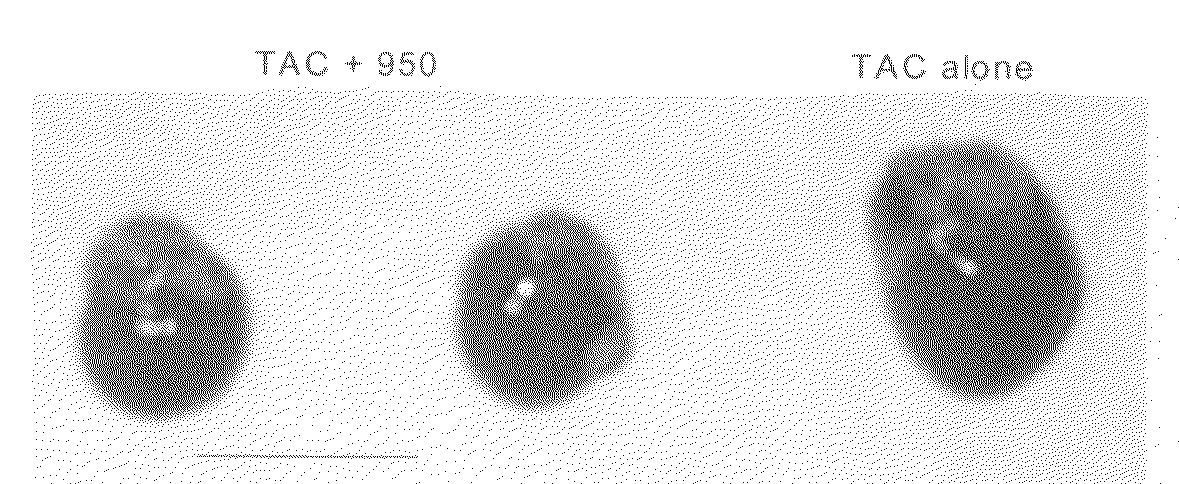Use of cis-epoxyeicosatrienoic acids and inhibitors of soluble epoxide hydrolase to reduce cardiomyopathy
a technology of soluble epoxide hydrolase and cis-eicosatrienoic acid, which is applied in the direction of prosthesis, blood vessels, drug compositions, etc., can solve the problems of high mortality rate, cardiac failure, morbidity and mortality, etc., and achieve cardiac arrhythmia inhibition, cardiac arrhythmia inhibition, and cardiac arrhythmia inhibition
- Summary
- Abstract
- Description
- Claims
- Application Information
AI Technical Summary
Benefits of technology
Problems solved by technology
Method used
Image
Examples
example 1
[0130]This Example sets forth materials and methods used in studies underlying the present invention.
[0131]All animal care and procedures were approved by the University of California, Davis Institutional Animal Care and Use Committee and complied with the Guide for the Care and Use of Laboratory Animals (NIH publication No. 80-213, 1985).
Mouse Model of Pressure Overload
[0132]Ascending aortic constriction was performed in 8-week-old male C57B1 / 6J mice (Charles River, Wilmington, Mass.). Animals were anesthetized with intraperitoneal ketamine 50 mg / kg and xylazine 2.5 mg / kg, and aortic constriction was created via a left thoracotomy by placing a ligature securely around the ascending aorta and a 26-gauge needle and then removing the needle. Immediately after the surgery, animals with ascending aortic stenosis were randomized and placed in one of the following regimens for three weeks: (a) compound 950 in drinking water (100 mg / ml), (b) AUDA-BE in drinking water, or (c) no drug. Age-m...
example 2
[0139]This Example reports the results of studies in an animal model of cardiac hypertrophy.
[0140]Thoracic aortic constrictions (“TACs”) were created in 8-week-old male C57Bl / 6J mice as described in Example 1, above, resulting in a chronic pressure overload induced cardiac hypertrophy. TAC-mice were randomized to receive either no therapy or one of two exemplar sEH inhibitors (compound 950 and AUDA-BE) in drinking water for a period of three weeks. An almost complete resolution of cardiac hypertrophy by the drug treatment was noted. This effect is independent of the anti-hypertensive action of the drugs, since the hearts were constantly exposed to the high afterload created by the aortic constriction.
[0141]FIG. 1 shows photomicrographs of examples of whole hearts from TAC-mice treated with compound 950 in the drinking water for three weeks compared to control untreated mice with TAC. All the mice were sacrificed at three weeks after the TAC was created. All the untreated TAC-mice sh...
example 3
[0143]sEH inhibitors have been previously investigated for the antihypertensive activities. Therefore, the question remained whether the antihypertrophic effects seen in Example 2 are the results of the antihypertensive activities of the sEHI. This was considered unlikely since our model produces a chronic constriction and a persistent increase in the afterload on the heart regardless of the systemic blood pressure. Nonetheless, to directly examine the effects of the sEH inhibitors on cardiac hypertrophy, a well documented model of in vitro neonatal cardiac myocytes and cardiac hypertrophy using phenylephrine or angiotensin II was adapted. Shown in the upper panels in FIG. 5 are confocal photomicrographs of primary culture of neonatal mouse cardiac myocytes treated with angiotensin II (ANG II) at low and higher magnification showing cells with cardiac hypertrophy after 48 hours of treatment with ANG II. Lower panels are of the same set of cells treated with both ANG II and with comp...
PUM
| Property | Measurement | Unit |
|---|---|---|
| mass median diameters | aaaaa | aaaaa |
| volume | aaaaa | aaaaa |
| concentrations | aaaaa | aaaaa |
Abstract
Description
Claims
Application Information
 Login to View More
Login to View More - R&D
- Intellectual Property
- Life Sciences
- Materials
- Tech Scout
- Unparalleled Data Quality
- Higher Quality Content
- 60% Fewer Hallucinations
Browse by: Latest US Patents, China's latest patents, Technical Efficacy Thesaurus, Application Domain, Technology Topic, Popular Technical Reports.
© 2025 PatSnap. All rights reserved.Legal|Privacy policy|Modern Slavery Act Transparency Statement|Sitemap|About US| Contact US: help@patsnap.com



